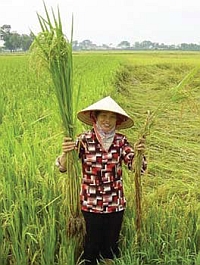A study by the Consultative Group on International Agricultural Research (CGIAR) identifies food production regions in the world most at risk from disruption due to climate change. Some of these populations, in Africa and South Asia for example, are already facing food shortages, while other food-producing regions including China and Latin America run the risk of disruption from shorter, drier, or hotter growing seasons.
The report by CGIAR’s research program on Climate Change, Agriculture and Food Security matched regions of the world deemed susceptible to food disruption against climate change models to produce detailed maps pinpointing potential trouble spots. Indicators of regions with potential food disruptions include those with a history of food insecurity, having large areas of land devoted to crop and livestock production, or at risk of losing the ability to produce some crops (e.g., maize or beans) because of increasing temperatures.
The researchers used climate models based on data collected by the Fourth Assessment Report from the United Nations Intergovernmental Panel on Climate Change to make predictions for shifts in temperatures and precipitation going out to 2050. The research team identified populations as chronically food-insecure if more than 40 percent of children under the age of five years fell well below the World Health Organization’s height-for-age standards.
The threats from climate change on food production in the next 40 years, according to the study, include growing seasons reduced by five percent or more in tropical regions that cover important crop producers, such as Mexico, Brazil, India, and countries in southern and western Africa, as well as southeast Asia. Growing seasons there could be reduced to 120 days or less.
In many of these countries, populations, including the farmers themselves, are already struggling. The report estimates there are 369 million people living in these agriculture-intensive areas that are exposed to further food shortages or disruptions.
Higher temperatures over the next 40 years could also imperil basic crops on which 56 million people in parts of West Africa, India, and China depend. The findings indicate that by the mid-2050s, maximum daily temperatures during the growing season could exceed 30 degrees C (86 F). This is close to the maximum temperature that beans can tolerate, while maize and rice yields may suffer when temperatures exceed this level.
Regions where food security is not a problem now, such as in parts of Latin America, could face supply disruptions by mid-century. The study says good growing conditions are likely to drop below 120 days per season in prime farming regions of northeast Brazil and Mexico.
Growing seasons of at least 120 days are considered critical not only for the maturation of maize and several other staple food crops, but also for crops grown to feed livestock. Parts of Latin America are also likely to experience temperatures too hot for bean production, a food staple in the region.
- Farmer Networks Key to Agricultural Innovation in Mexico
- Russian, U.S. Scientists Develop Online Agricultural Maps
* * *


 RSS - Posts
RSS - Posts
[…] Read more: Study Highlights Crop Regions At Risk from Climate Change […]
[…] Read more: Study Highlights Crop Regions At Risk from Climate Change […]